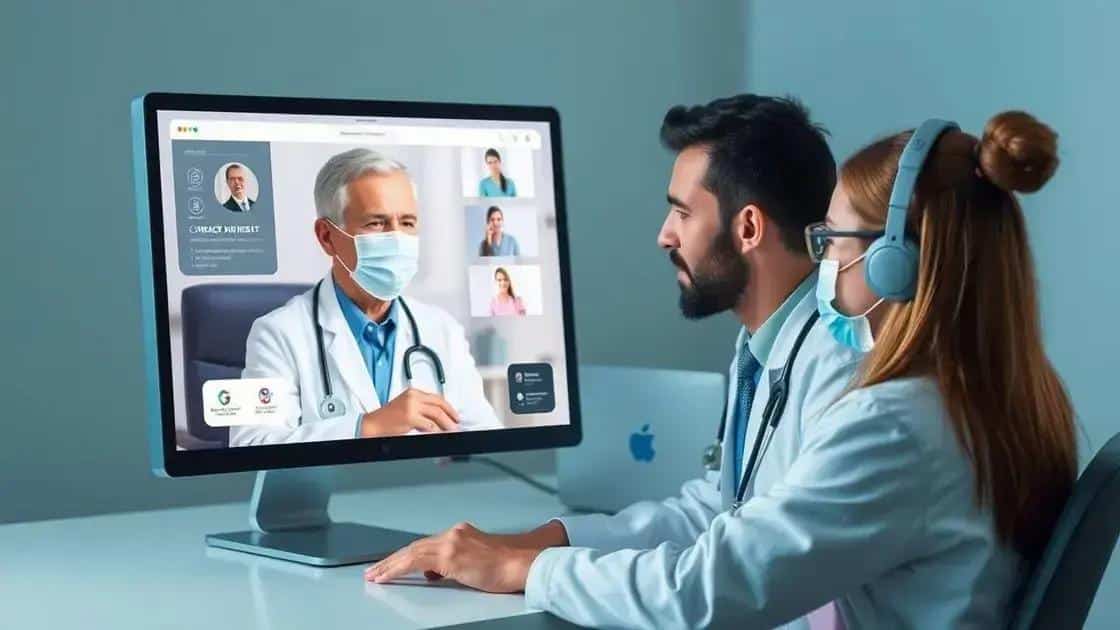Big healthcare system news: what you need to know today

Healthcare systems today face significant challenges, including rising costs, access issues, and workforce shortages, which necessitate innovative solutions for effective patient care and improved health outcomes.
Big healthcare system news is constantly evolving, and it can sometimes feel overwhelming to keep up. What if these updates could actually transform your understanding of healthcare? In this article, we’ll dive into the latest trends, challenges, and innovations shaping the industry.
Recent developments in healthcare systems
Recent developments in healthcare systems highlight important changes that can improve patient experiences and outcomes. With advances in technology and innovative policies, the landscape of healthcare is constantly evolving.
Technology Integration
One major shift has been the integration of technology into healthcare practices. Digital tools are being used to enhance service delivery and patient care. For instance, electronic health records (EHR) streamline patient information access, allowing for better coordination among healthcare providers.
Benefits of Telehealth
Another vital development is the rise of telehealth services. This approach allows patients to receive care from the comfort of their homes. Some benefits include:
- Reduced travel time and costs
- Increased access to specialists
- Convenient scheduling
- Improved patient engagement
Telehealth has not only made healthcare more accessible but also has transformed the way healthcare providers interact with patients. This shift can lead to better health outcomes.
Policy Changes Impacting Care
Policy changes at both state and federal levels also play a crucial role in shaping healthcare systems. Recent policies aim to increase funding for primary care and mental health services, which are essential for comprehensive patient care. Such changes promise to enhance the overall quality of care available to patients.
As we look toward the future, embracing innovations will be key to strengthening healthcare systems. Collaborations between medical professionals, technology innovators, and policymakers can create a more effective healthcare environment for everyone.
Impacts of policy changes on patient care
Impacts of policy changes on patient care are significant and can directly affect how healthcare is delivered. Recently, there have been various updates that aim to enhance the quality of care and improve access for patients.
The Shift toward Value-Based Care
One notable change is the shift toward value-based care models. This approach focuses on improving patient outcomes rather than just the quantity of services provided. It emphasizes preventive care, encouraging healthcare providers to prioritize wellness and early interventions.
- Enhanced patient satisfaction
- Reduced healthcare costs for patients
- Improved health outcomes over time
As providers adopt value-based care, the emphasis on individualized treatment plans grows. This means more attention is given to the specific needs of each patient, fostering a better relationship between patients and their healthcare providers.
Expanding Access through Legislation
Legislative changes have also played a pivotal role in increasing access to care. Policies aimed at expanding insurance coverage, such as Medicaid expansion, help millions of individuals receive the necessary medical services. For many, this is a crucial step toward achieving wellness.
Moreover, the introduction of telehealth services has made it easier for patients to connect with their providers without geographical limitations. This flexibility is vital for those living in remote areas or with transportation challenges.
Finally, as policymakers advocate for mental health parity, patients can expect better access to mental health resources. This is critical, as addressing mental health is just as important as physical health to achieve overall well-being.
Innovations driving efficiency in healthcare

Innovations driving efficiency in healthcare are transforming the way services are delivered to patients. With advancements in technology and new practices, healthcare systems can operate more smoothly and effectively.
Electronic Health Records (EHR)
One key innovation is the implementation of Electronic Health Records (EHR). EHR systems allow healthcare providers to access patient information quickly and securely. This means that doctors can make informed decisions faster and with greater accuracy. EHR reduces paperwork and the likelihood of errors, improving overall patient safety.
- Instant access to patient history
- Streamlined communication between providers
- Enhanced coordination of care
The impact of EHR is significant as it lays the groundwork for more integrated healthcare solutions. Care teams can easily collaborate and ensure that all members are informed about a patient’s needs.
Telemedicine
Another major innovation is telemedicine, which has grown tremendously, especially during recent years. It allows patients to receive care remotely through video calls or secure messaging. This increases access to healthcare services, particularly for individuals in rural areas.
Patients benefit from telemedicine as it saves travel time and reduces costs. They can address minor health concerns from home, leading to quicker resolutions without the need for a physical visit.
In addition, telemedicine has proven essential during emergencies or public health crises, ensuring that healthcare remains accessible while minimizing exposure risks.
As healthcare providers continue to adopt these innovations, the focus remains on improving efficiency and enhancing patient care. By embracing new technologies, healthcare systems can create a more responsive and proactive environment for patients.
The role of technology in modern healthcare
The role of technology in modern healthcare is vital in reshaping how care is delivered to patients. By leveraging innovative tools, healthcare providers can enhance efficiency and improve patient outcomes.
Wearable Health Devices
One significant technological advancement is the use of wearable health devices. These gadgets, like fitness trackers and smartwatches, monitor vital signs such as heart rate, activity levels, and sleep patterns. Patients can easily track their health metrics, giving them more control over their wellness.
- Real-time health monitoring
- Encouragement of healthy lifestyles
- Data sharing with healthcare providers
Wearable devices empower patients by providing insights into their health and promoting proactive health management. This can lead to better conversations with doctors and more personalized care.
Artificial Intelligence in Diagnostics
Another key element is the incorporation of artificial intelligence (AI) in diagnostics. AI algorithms can analyze medical images and data with precision, enhancing the speed and accuracy of diagnoses. For instance, AI can help detect conditions such as cancer earlier than traditional methods.
This technology takes a burden off radiologists and provides them with advanced tools to support their decisions. By alleviating some tasks, AI allows healthcare professionals to focus more on patient care.
Additionally, AI is valuable in predicting patient outcomes and recommending treatment plans tailored to individual needs. As technology advances, the potential for AI to help in healthcare will continue to grow.
Modern healthcare is being transformed by technology in many ways. From wearable devices to AI applications, innovations are helping to create a more effective and responsive healthcare system.
Challenges facing healthcare systems today
Challenges facing healthcare systems today are numerous and complex. Understanding these obstacles is key to finding effective solutions that enhance patient care and system efficiency.
Rising Healthcare Costs
One major challenge is the rising costs of healthcare. Many patients struggle with high premiums, deductibles, and out-of-pocket expenses. These financial barriers can prevent individuals from seeking necessary medical care.
- Increased insurance premiums
- High costs of medications
- Expensive hospital stays
As costs continue to rise, there is a pressing need for healthcare reform to make services more affordable for everyone.
Access to Care
Another significant issue is access to healthcare. Many individuals, particularly in rural areas, face difficulties in obtaining care. Limited availability of healthcare facilities and professionals can lead to long travel distances for treatment.
For many patients, especially those with chronic conditions, this barrier to access can result in delayed diagnoses and treatment, worsening health outcomes.
Workforce Shortages
Healthcare systems are also dealing with workforce shortages. A lack of qualified healthcare professionals can strain resources and impact patient care. As the population ages and demand for healthcare increases, it is essential to address this shortage.
Efforts to attract and retain healthcare workers are critical, including the need for better working conditions and support. This will ensure that healthcare professionals can deliver high-quality care without being overwhelmed.
Overall, identifying and overcoming these challenges is essential for creating a more efficient and equitable healthcare system. Addressing costs, improving access, and expanding the workforce will lead to better outcomes for all patients.
FAQ – Common Questions About Challenges in Healthcare Systems
What are the main challenges facing healthcare systems today?
The main challenges include rising costs, access to care, workforce shortages, and the need for equitable solutions.
How do rising healthcare costs affect patients?
Rising costs can lead to higher insurance premiums and out-of-pocket expenses, making it difficult for patients to seek necessary care.
Why is access to healthcare a problem in rural areas?
In rural areas, limited healthcare facilities and providers create obstacles that prevent individuals from receiving timely medical services.
How can technology help address some of these challenges?
Technology like telemedicine and electronic health records can improve access and efficiency in healthcare delivery, helping to overcome various barriers.





